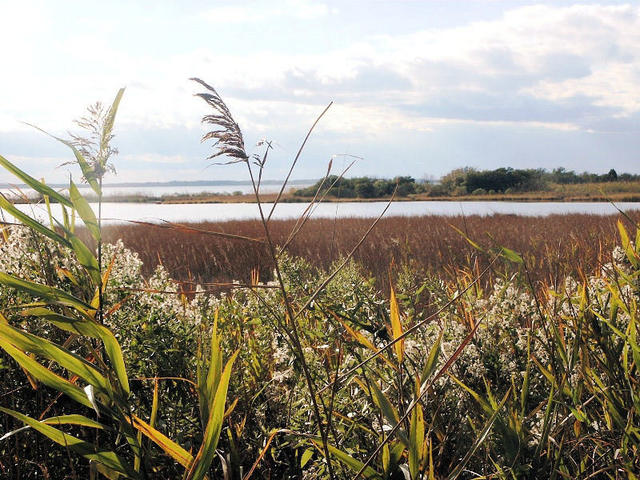Home » Regions » North America » Eastern Temperate Forests » Mississippi Alluvial & Southeast USA Coastal Plains » Middle Atlantic Coastal Plain » Chesapeake-Pamlico Lowlands and Tidal Marshes
Chesapeake-Pamlico Lowlands and Tidal Marshes
Last updated: August 18th, 2020
↑About the Chesapeake-Pamlico Lowlands and Tidal Marshes
The Edit Chesapeake-Pamlico Lowlands and Tidal Marshes, also called the Chesapeake-Albemarle Silty Lowlands and Tidal Marshes, is a flat, low-elevation region mostly surrounding the Chesapeake bay and the larger tidal rivers and sounds in North Carolina.This region is low elevation and almost completely level, and is characterized by extensive brackish wetlands, marshes, ponds, and swampy, slow-moving streams. The underlying substrates are sedimentary, and there is abundant sand, silt, clay, and other alluvial deposits. Tidal marshes are most common on the flatter eastern shore of the Chesapeake bay, as well as the portions of this region in North Carolina. Parts of the area, especially in the south, have soils that are seasonally wet in winter and early spring. The region also includes Lake Mattamuskeet, the largest freshwater lake in North Carolina.
Natural vegetation is Oak-Hickory-Pine forests on drier ground, with dominant species being hickory (Carya sp.), longleaf pine (Pinus palustris), shortleaf pine (Pinus echinata), and loblolly pine (Pinus taeda), along with white oak (Quercus alba) and post oak (Quercus stellata). There are also southern floodplain forests and northern cordgrass prairies. This region also had a large portion of nonriverine wet hardwood forests, with dominant trees including swamp chestnut oak (Quercus michauxii), cherrybark oak (Quercus pagoda), laurel oak (Quercus laurifolia), water oak (Quercus nigra).
Better-drained sites are commonly used for agriculture, including production of corn, wheat, soybean, and potato. but significant forest cover also remains, and there is significant poultry production. Significant areas have been drained for agriculture, but due to the flat topography, some of these attempts failed, including an abandoned attempt to drain Lake Mattamuskeet. Although much of this region is sparsely populated, it contains significant urban and industrial areas around the Baltimore harbor and the Hampton Roads area, as well as some military installations.
Logging and forest clearing has increased the portion of early-successional species. On wet sites, there is more American sweetgum (Liquidambar styraciflua) and red maple (Acer rubrum) and loblolly pine than probably ocurred here originally.
This region extends much farther inland on the eastern shore of the bay, where it is bordered to the east by the higher and better-drained Delmarva Uplands. The north section of the bay is bordered to the north and west by the more upland Chesapeake Rolling Coastal Plain, and this border is abrupt, extending to the water's edge in some areas, where cliffs occur. Farther south, this region is bordered to the west by the Rolling Coastal Plain. At it southern end it is interspersed with the Swamps and Peatlands and bordered to the west by the Mid-Atlantic Flatwoods.
 This photo shows a tidal marsh at Eastern Neck National Wildlife Refuge, one of the larger preserves in the Chesapeake-Pamlico Lowlands and Tidal Marshes region. Low-lying marshy areas are dominated by grasses, and woody plants are only found on higher ground, visible here in the distance. Photo © Robert Pos, CC BY 2.0, Source.
This photo shows a tidal marsh at Eastern Neck National Wildlife Refuge, one of the larger preserves in the Chesapeake-Pamlico Lowlands and Tidal Marshes region. Low-lying marshy areas are dominated by grasses, and woody plants are only found on higher ground, visible here in the distance. Photo © Robert Pos, CC BY 2.0, Source.Plant Lists & In-Region Search
We do not yet have data to generate plant lists for a region as fine-tuned as this one. However you can move up to the broader Middle Atlantic Coastal Plain and generate lists for that region: native plants or all plants. Or search that region's plants here:
↑References
1. Woods, A.J, Omernik, J.M., Brown, D.D. "Level III and IV Ecoregions of Delaware, Maryland, Pennsylvania, Virginia, and West Virginia", U.S. Environmental Protection Agency: National Health and Environmental Effects Research Laboratory, Corvallis, OR (1999) Web.
2. Comstock, J.A.; Griffith, G.E.; Omernik, J.M. "Ecoregions of North Carolina: Regional Descriptions", (2002) Web.


